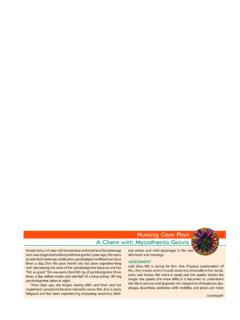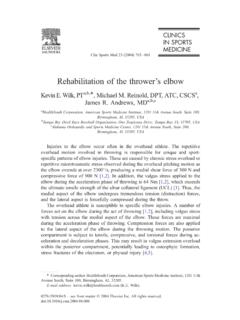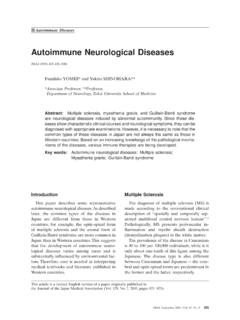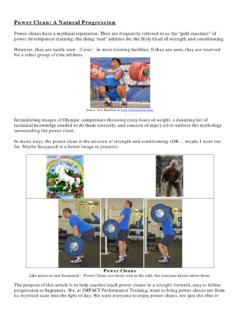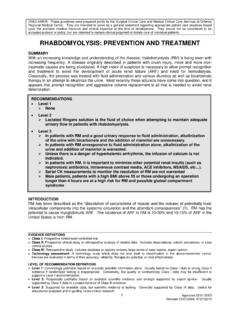Transcription of Charcot-Marie-Tooth Disease (CMT) What is Charcot-Marie ...
1 Version: 2. Published: January 2004. Updated: December 2009. Date of review: November 2011. Author: MD, FRCP, FRCPE. Clinical Director, Oxford MDC Muscle and Nerve Centre, and revised by Dr. Mary Reilly MD, FRCP, FRCPI Consultant Neurologist, National Hospital for Neurology and Neurosurgery, London, UK. Charcot-Marie - tooth Disease (CMT). Sometimes known as Hereditary Motor and Sensory neuropathy (HMSN) or Peroneal muscular Atrophy (PMA). What is Charcot-Marie - tooth Disease ? Charcot-Marie - tooth Disease is named after the three neurologists who first described the condition in 1886. Many different names have been used to describe CMT but the other commonly used name is hereditary motor and sensory neuropathy (HMSN). This is an accurate term as it refers to the two primary features of this condition the condition is hereditary and affects the motor and sensory peripheral nerves.
2 CMT or HMSN therefore is used to describe a group of conditions that give rise to weakness and wasting of the muscles below the knees and often those of the hands. Many affected people also have loss of feeling in the hands and feet, and this is the sensory' component. The term neuropathy refers to the fact that it is the peripheral nerves (which connect the spinal cord to the muscles, joints and skin, carrying messages in both directions), which do not function normally. As the name implies, these are inherited disorders. CMT is also referred to as peroneal muscular atrophy, because the peroneal muscles on the outer side of the calves are particularly affected. Other names include Dejerine-Sottas Disease and hereditary hypertrophic neuropathy. The term CMT is now the favoured term and is the term most commonly used in the literature. CMT does not describe a single disorder, but a group of conditions that are superficially similar.
3 It is important to determine exactly what kind of CMT someone has, and this can be achieved by careful examination, taking a family history, electrical tests (nerve conduction studies), and genetic studies on blood samples. This sort of assessment also serves to distinguish CMT from other non-genetic causes of neuropathy, and this is particularly important in people who do not have affected relatives. The different types of CMT. Peripheral nerves can be thought of as being electrical cables: the fibres (like wires) run down the middle and are wrapped in insulating material (myelin). If the myelin is damaged the nerve impulses tend to be conducted more slowly than usual. If the fibres (also called axons) are damaged, the speed of conduction is normal but the size of the signal is reduced. These changes can be detected by electrical tests. Traditionally, the commonest forms of CMT have been divided into two types: in type 1 the damage is to the myelin resulting in slow conduction, and this is referred to as the demyelinating type of CMT, whereas in type 2 it is the nerve fibres that are at fault and the term axonal type CMT is used.
4 Although major advances have been made in the last decade in the identification of the genes responsible for CMT, not all of the genes associated with CMT have yet been identified. This means that the electrical test (nerve conduction studies) is still often very useful in making the diagnosis. An exception is when there is a clear family history of autosomal dominant inheritance (see below), when DNA testing for the commonest form of CMT (type 1A) might be performed as a first investigation. Although the electrical tests are usually clearcut, allowing a diagnosis of CMT type 1 or CMT type 2, in some cases it may be difficult to decide from the electrical test which type of CMT a patient has and the term intermediate CMT is used. Although this can be confusing for patients it is useful for doctors in deciding which genes to screen. In the future, when all the causative genes are identified, a comprehensive classification of CMT will be available but in view of the fact that there are likely to be numerous genes involved it is probable that electrical tests will remain important in the initial assessment of patients.
5 Previously, the term HMSN III was applied to patients with a particularly severe form of HMSN starting in very early life. HMSN III is also called Dejerine Sottas Disease (DSD) and Congenital hypomyelinating neuropathy (CHN) and both these terms are commonly used clinically. HMSN III was thought to be inherited in an autosomal recessive pattern, unlike the autosomal dominant pattern of inheritance of the common types of CMT types 1 and 2 (see below). We now know that HMSN III is usually associated with a defect in the genes that cause CMT type I and that most cases are a result of a new mutation in the gene, which explains why neither parent was affected. Therefore the term HMSN III is no longer commonly used, having been replaced by the terms CMT 1, DSD and CHN. Occasionally DSD and CHN. can be inherited in an autosomal recessive manner. There are other more complex forms of CMT in which the neuropathy is combined with other features such as deafness, visual problems, vocal cord paralysis and breathing difficulties but these are all very rare.
6 How does CMT affect people? The first evidence of CMT is usually between the ages of 5 and 15 but sometimes may not be until very much later, even into middle-age. Usually the first symptom is slight difficulty in walking because of problems with picking up the feet, and this may well be noted by parents first. Many people, particularly those with CMT type I, have high arched feet (referred to as pes cavus) and this may be obvious from a very early age. It tends to become particularly noticeable at the time of the growth spurt associated with puberty. Weakness of the hands occurs in some people, but this does not usually cause symptoms until after the age of 20. Patients can experience numbness of the feet and hands (usually noticed in the feet first) which is not often troublesome, but the tendency to have cold feet is frequent. Very rarely the numbness can be severe, and it is then easy for affected individuals to injure themselves without knowing it; painless ulcers of the feet may develop as a result of poorly fitting shoes, or burns on the hand from hot cups etc.
7 Pain is not a common feature of CMT and if present may be due to secondary effects on the joints or muscles. The reflexes (such as the knee jerk) are commonly lost. This does not cause any trouble for the individual, but is often noted early on by doctors. A few people with CMT 1 have shakiness of the hands (tremor) and the combination of tremor and CMT is sometimes referred to as the Roussy-Levy Syndrome. Mild curvature of the spine (scoliosis) occurs in some people and tends to be more severe in those with early onset of limb problems. The types of CMT which run through the generations in families (see section on dominant inheritance). are not usually severely disabling disorders and often do not change a great deal after people have finished growing. It is unusual for people with CMT to lose the ability to walk, although some older people need a stick or other walking aids.
8 It is important to stress that the disorder often varies enormously in severity, even in members of the same family, and 10 to 20% of affected individuals have no symptoms at all but are found to have evidence of the condition on examination or using electrical tests. How is CMT inherited? The commonest forms of CMT are inherited in a way that is referred to as autosomal dominant (AD). This type of inheritance is the most common type in CMT 1 and CMT 2. We all have two copies of every gene and in AD inheritance, the affected person has one abnormal gene and one normal gene. Each child will only inherit one gene from an affected parent (the other gene will come from the other parent). and therefore each child of an affected parent has a 50% chance of inheriting the abnormal gene and being affected. People of either sex can have the condition. However in occasional families with CMT 1 and CMT 2 the inheritance is autosomal recessive (AR).
9 In AR inheritance a person needs two abnormal copies of the gene to be affected unlike AD inheritance where the person only needs one copy of the abnormal gene to be affected (see above). AR inheritance is only seen if both parents are carriers' of the faulty gene but these parents do not themselves have any symptoms. Both parents therefore have one abnormal and one normal copy of the gene. The condition develops only if a child inherits the abnormal gene in a double dose, one from each parent. Each child of such parents has a 25% chance of inheriting an abnormal copy form both parents (double dose) and being affected. Each child of such parents will have a 50% chance of inheriting one abnormal copy of the gene from either parent and be a carrier of the condition and each child will have a 25%. chance of inheriting two normal genes (one from each parent).
10 Males and females can be affected. Many people with autosomal recessive CMT do not have affected relatives as each child has only a 1 in 4 chance of being affected and most families are quite small. It is therefore common for only one child to be affected. In some families, CMT is caused by an X-linked gene (X-linked inheritance) which is carried on the X. chromosome, one of the so-called sex chromosomes which determine the sex of the child (females are XX, males are XY). The result is that boys inherit the Disease from their mothers who are known as carriers. Carriers may show no sign of Disease , although sometimes they are mildly affected, but each of their sons has a 50% chance of having CMT and each of their daughters has a 50% chance of being a carrier. Affected males cannot transmit the Disease to their sons. In these families therefore, males are more severely affected than females and males cannot pass on the Disease to their sons.
